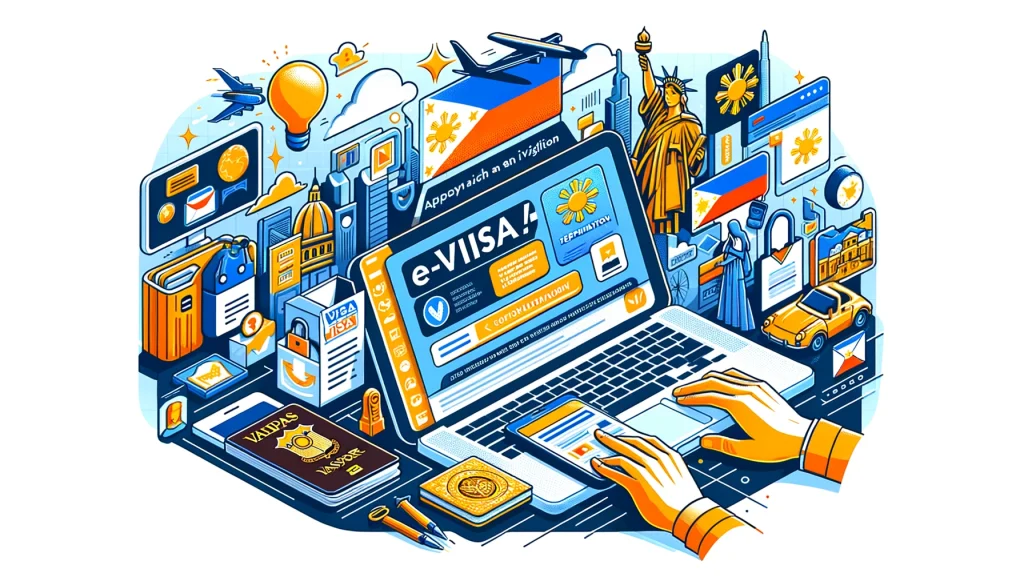Traveling to the Philippines has become more convenient with the introduction of the e-Visa system.
This digital approach to obtaining a visa simplifies the process, making it accessible and efficient for travelers worldwide.
This article provides an in-depth look at the e-Visa for the Philippines, covering necessary documents, the application process, benefits, and more.
Necessary Documents and Information for the e-Visa Application
To apply for a Philippine e-Visa, you will need the following:
- Valid Passport: Your passport should be valid for at least six months beyond your intended stay in the Philippines.
- Digital Passport Photo: A recent passport-sized photo in digital format.
- Travel Itinerary: Details of your flights and accommodation.
- Proof of Financial Means: Such as bank statements or a letter from a sponsor.
- Email Address: For receiving the e-Visa and communications.
e-Visa vs. Traditional Visa
The primary difference between an e-Visa and a traditional visa is the application process.
An e-Visa can be applied for and received entirely online, eliminating the need to visit an embassy or consulate.
Traditional visas require a physical application, potentially including an in-person interview.
e-Visa Application Process for the Philippines
- Online Application: Complete the application form on the official e-Visa portal for the Philippines.
- Submit Documents: Upload the necessary documents in digital format.
- Payment: Pay the e-Visa fee online through the payment portal.
- Approval and Receipt: Once approved, you’ll receive your e-Visa via email. Print it out to present upon arrival.
Why Choose an e-Visa?
Opting for an e-Visa offers several benefits:
- Convenience: Apply from anywhere, anytime.
- Time-saving: No need to visit embassies or wait in long queues.
- Fast Processing: e-Visas are often processed more quickly than traditional visas.
What is a Single Entry e-Visa?
A single entry e-Visa allows the holder to enter the Philippines once. After leaving, regardless of the visa’s validity period, you must apply for a new visa to re-enter the Philippines.
Countries Eligible for the Philippines e-Visa
The Philippine government periodically updates the list of countries eligible for an e-Visa. Typically, these include nations with strong diplomatic ties to the Philippines.
It’s essential to check the official Philippine e-Visa portal for the most current list.
Countries Not Eligible for the Philippines e-Visa
Similarly, some countries might not be eligible for the e-Visa due to various diplomatic and security reasons.
Again, refer to the official e-Visa website for up-to-date information.
Frequently Asked Questions
Can I extend my stay in the Philippines with an e-Visa?
- Extensions may be possible through the Bureau of Immigration in the Philippines, depending on your visa type.
Is the e-Visa fee refundable if my application is denied?
- Typically, visa application fees are non-refundable. Check the terms and conditions on the e-Visa portal.
How long before my trip should I apply for an e-Visa?
- It’s recommended to apply at least two weeks before your planned travel to accommodate processing times.
Can I work in the Philippines with an e-Visa?
- No, the e-Visa is usually issued for tourism or business visits. A work visa is required for employment purposes.
What should I do if I don’t receive my e-Visa?
- Contact the support team through the e-Visa portal. Ensure you provide all necessary information for them to assist you effectively.
The e-Visa system represents a significant step forward in making travel to the Philippines more accessible and streamlined.
By understanding the requirements, process, and advantages of an e-Visa, travelers can prepare more effectively for their journey to this beautiful archipelago.
For more information on the e-Visa application process, including eligibility and requirements, consider visiting the following official resources:
- Philippine Bureau of Immigration: https://immigration.gov.ph/
- Department of Foreign Affairs – Republic of the Philippines: https://www.dfa.gov.ph/
- Official Philippine e-Visa Portal: While a specific URL for an e-Visa portal was not provided, checking the Bureau of Immigration and Department of Foreign Affairs websites can direct you to the latest updates and official platforms for e-Visa applications.



